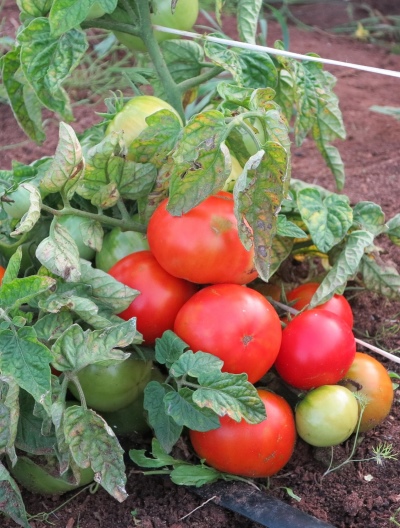
- Authors: Motov Victor Mikhailovich, Ostanina Olga Borisovna, Kharitonov Sergey Evgenievich (Russia)
- Year of approval: 2015
- Category: grade
- Growth type: determinant
- Appointment: universal
- Ripening period: early
- Ripening time, days: 83-90
- Growing conditions: for open ground
- Bush size: undersized
- Bush height, cm: 40-60
Tomato Ascetic is able to please both the most discerning gardeners and gardeners. But before you rush to grow it, you need to find out the basic subtleties and nuances. The planting scheme and the principles of caring for such a plant are also important.
Breeding history
Ascetic is a completely new culture. Its use is authorized in 2015. The authors of the development were Russian breeders Mokhov, Kharitonov and Ostanina.
Description of the variety
Ascetic is a determinant universal variety. Its qualities are good enough for cultivation even in risky farming areas. The bushes reach a maximum height of 0.4-0.6 m. It should be noted that this is a typical standard crop.
The main qualities of the fruit
As is typical for other tomatoes, the ripe Ascetic berries have a rich red tone. The weight of one specimen varies from 80 to 100 g. The smoothness of the skin can also be considered a characteristic feature. It is stated that some fruits can reach a mass of 150 g. They are divided into a large number of chambers.
Taste characteristics
According to the stories of farmers and tasters, the variety leaves a favorable impression. The taste of tomatoes will delight even the most demanding people. The ascetic can compete in gastronomic performance with any other open field tomato. It is used both fresh and in the preparation of salads.
Ripening and fruiting
The descriptions indicate that the Ascetic ripens early. It takes 83 to 90 days for its fruits to reach maturity. Even in the Urals, it will be possible to harvest the crop as early as mid-July. In the middle lane, sometimes it turns out to feast on fruits even earlier.
Yield
The cultivar is considered a prolific plant. Up to 3.5 kg of tomatoes will ripen on 1 bush per season. But this result is achieved only with scrupulous implementation of agrotechnical standards. Under unfavorable conditions, the collection may not meet expectations.
The timing of planting seedlings and planting in the ground
It is necessary to sow seeds in containers no earlier than April 10. In unfavorable weather conditions, this period will have to be further postponed. It should be noted that the plant tolerates rather harsh cold weather, but this applies only to adult bushes, and not to seeds or young growth.

Growing tomato seedlings is an extremely important process, because it largely depends on whether the gardener will be able to harvest at all. All aspects must be taken into account, from seedbed preparation to planting in the ground.
Landing scheme
The planting requirements for this variety are traditional - per 1 sq. m place no more than 4 plants. If you need more careful maintenance, typical for a regular vegetable garden, you can limit yourself to 3 bushes. The distance between seeds in seedling containers is also determined as a general rule.

Growing and care
There is no need to tie the Ascetic bush to the supports of the Ascetic bush. The use of complex mineral fertilizers is encouraged. An alternative solution is to use azophoska, independently combined with potassium sulfate, magnesium sulfate and trace elements. For 1 m2 of land, 40 g of the complex composition and 10 g of magnesium sulfate are used. With autumn feeding with rotted organic matter, summer mineral feeds are practically not required, and you can limit yourself to regular watering.
It is advisable to grow the ascetic on black bedding materials such as lutrasil. This solution allows moisture retention and protects the roots from excessive heat. In addition, covering materials guarantee the rejection of the garter. Despite the absence of the need for special shaping, it is recommended to remove all stepchildren up to the 1st hand. There are no more subtleties here.




A plant needs different micronutrients at each stage of growth. All fertilizers can be divided into two groups: mineral and organic. Folk remedies are often used: iodine, yeast, bird droppings, eggshells.
It is important to observe the rate and period of feeding. This also applies to folk remedies and organic fertilizers.
Disease and pest resistance
The culture can successfully resist late blight. Protection measures, if required, will be minimal. There is practically no information about resistance to other diseases. Therefore, it is necessary to protect the culture from other infections and harmful insects in established ways. An important role is played by preventive treatments with special branded drugs according to the instructions (improvised means are ineffective).


Growing regions
The Ascetic tomato is zoned for the risky farming zone.It can be safely grown in the northern regions of the Russian Federation. The only exceptions are areas with particularly extreme conditions, including permafrost. Given this, the cultivation of such a tomato in the temperate zone and the middle zone, especially in the southern regions, is not difficult. The difference will only concern the difficulties with the cover.

























































































